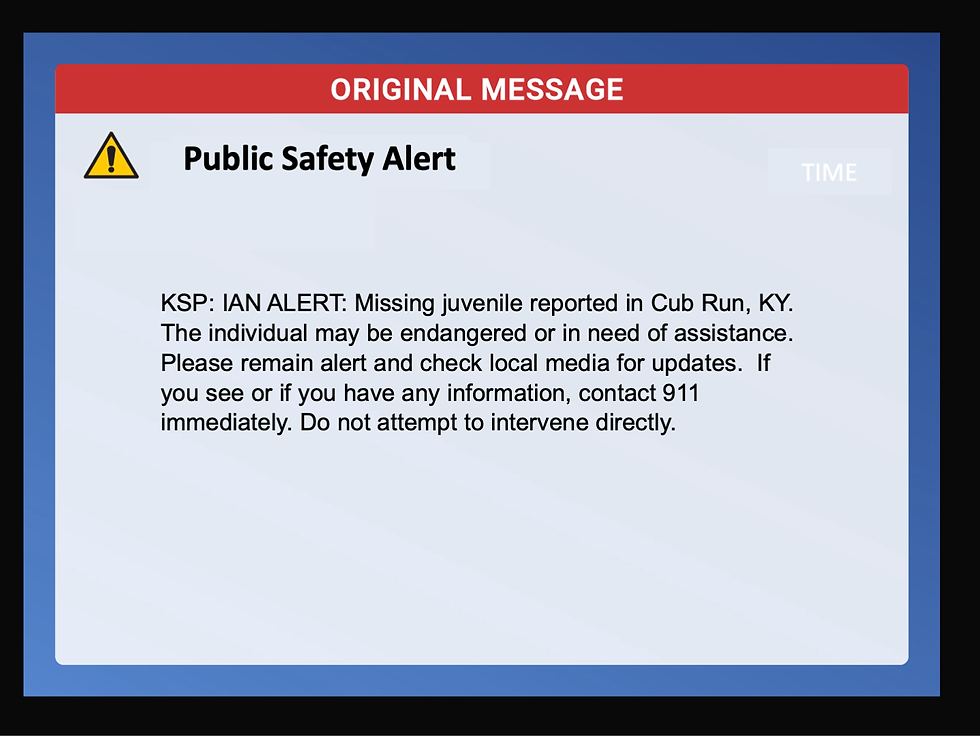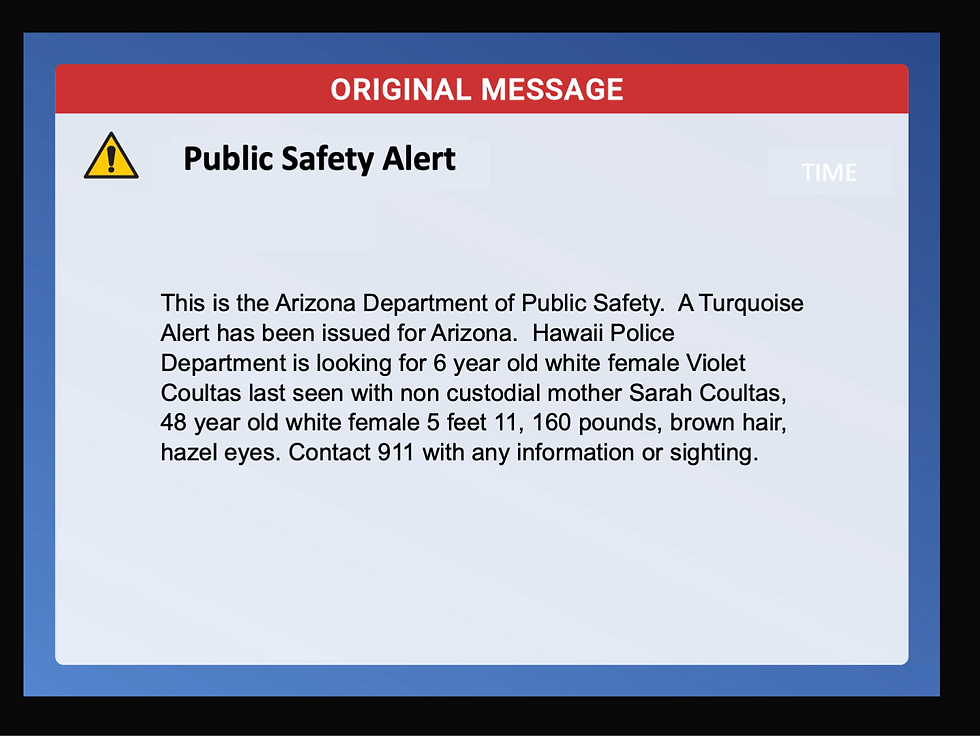Missing Person Alert Jargon: Ashanti, Ian, and Turquoise
- Jeannette Sutton

- Jul 24
- 4 min read
Updated: Jul 25
When we take a look at the most prevalent WEA messages, the #1 type, following those issued by the National Weather Service for meteorological events, is missing persons. This includes missing persons of all sorts - children, college students, and adults. And those messages seem to be increasing. But as they do, we really need to get a handle on how to best communicate them so that they are actionable.
To do so, I thought it would be useful to take a look at three recent messages and point out some areas for improvement.

The first example is an Ashanti Alert that was issued in Wyoming. In this case, the alerting authority sent the same message for both a 90- and 360-character message, severely underutilizing the additional characters available to describe what is taking place and why people should pay attention. Noticeably, the alert is missing the source of the alert (no sender); it uses jargon to name an alert type (Ashanti Alert); and provides a vehicle description and a "subject" name. There is a bit of guidance to the message receiver "if seen call 911," but this message is severely lacking for anyone who is not familiar with the jargon "Ashanti Alert."
Initial questions that one can assume are: what is an Ashanti Alert? Is the subject dangerous? What does the subject look like? Is the subject carrying a weapon?
Also, why is this message IN ALL CAPITAL LETTERS? Is it to express urgency? Are they trying to yell in text? Was their keyboard stuck?

The second example is for a message issued in Kentucky for an "IAN ALERT." In this case, the sender is identified as "KSP" and there is some explanation of what is taking place with a description that a juvenile was reported missing, in a specific location, and that they may be endangered. Guidance is provided to remain alert and check local media, to contact 911 if you have any information, but also not to attempt to intervene directly.
This message was issued for the entire state of Kentucky and, after some additional investigating, we learn that an Ian Alert is issued for a person with autism, meaning that there may be additional cues that could be added about expected behaviors, especially related to seeking water. Recently, autism advocates have begun to ask law enforcement to include the phrase "search water first" due to the high number of drowning deaths in children with autism.
Notably, this message also included no details about the juvenile including age, gender, race, height, etc., or clothing or other identifying markers. Nor do they offer clues about when they were last seen or if thee is a reason to believe they may be far beyond the geographic area of Cub Run, KY. Including a link to more information would be a useful addition.

A third example is a "turquoise alert" issued for the state of Arizona. In this case, AZ is assisting another state in searching for a missing person who had last been seen in the area of interest (Phoenix airport) 12 days earlier. This message includes the sender, a description of the missing person and the person they are believed to be traveling with, along with a call to action (contact 911 with information or sighting). No link to more information is provided and the message receiver would not know that the missing person was last seen in the state nearly two weeks prior.
While all three of these messages have specific details that they are lacking, it is important to also note that all three are using law enforcement jargon in place of a plain language description of the message topic. In each case, the message is being issued for a missing person. Ashanti Alerts have a national standard, in a manner similar to the standards established for AMBER Alerts, and are issued for adults with some sort of impairment; Ian Alerts are local only to the state of Kentucky and are issued for persons with autism; Turquoise Alerts are local only to the state of Arizona and are issued for missing persons who do not fit the criteria for AMBER Alerts.
For missing person alerts, there are more than 40 types of "named" or "color-coded" alerts. Most of these are local to an individual state and created by law, meaning that if they are to be used within a state there needs to be significant public education for people to know what the name/color means and why it is important to intervene. The AMBER Alert program has invested decades of marketing and public education to help people know that it means a missing child who is at risk of severe harm. State-level alerts; not so much.
To improve missing person alerts, we need to move away from the use of jargon and rely on a plain language approach. It is also important to create complete messages that describe the location a person was last seen, the time seen, providing a description of the person and, if available, a suspect and mode of transportation. If there are clear instructions for people to follow to help location the person, those should be a top priority for inclusion.
Too often missing person messages are seen as an annoyance with too little information sent to too many people using too much jargon. We can clearly improve these messages.
For more recommended contents, be sure to download The Warning Lexicon - it's free and offers step-by-step instructions on how to write a better warning message.
________________________________________________________________________
Feel free to post this on your social media site, just remember to attribute it to The Warn Room and include the web address: TheWarnRoom.com - Thank you!
You may click on the keywords below to find other entries with similar topics.


